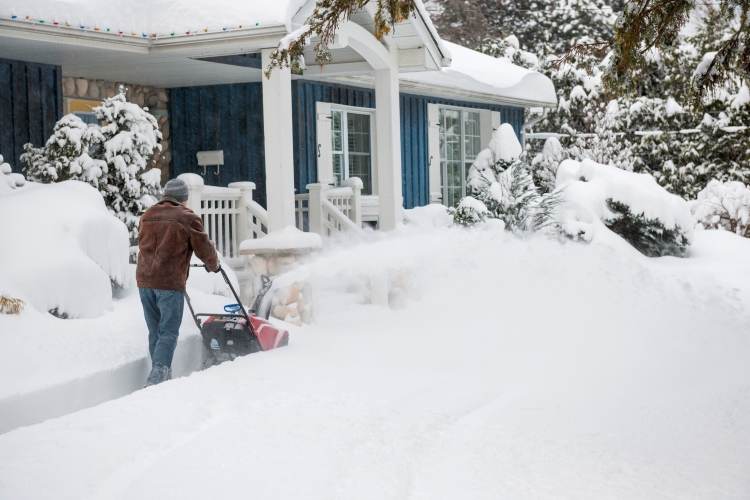Old Man Winter has a nasty habit of blowing into town when we least expect him, which means we may not always be able to prepare for a storm before it strikes. But even after the snow has stopped falling, there are still steps you can take to stay safe and prevent further damage.
Look After Yourself and Your Loved Ones
If you or someone you’re with needs medical care during or after a winter storm, you can access the Red Cross’s First Aid app for advice while you wait for medical professionals to arrive. It offers interactive guidance on how to deal with many emergency situations, which can help you make informed decisions to help either yourself or the person you’re looking after. If you can download it, do so. It comes preloaded with content, so if your internet connection goes out, you’ll still be able to get the help you need.
If there’s a local evacuation or widespread damage, the Federal Emergency Management Agency (FEMA) can help you decide on next steps. Visit their website or download their app to get access to:
- Maps
- Directions to disaster recovery centers
- A portal where you can apply for federal disaster assistance, if necessary.
Clear Ice and Snow From Your Roof
After a winter storm, snow and ice can place significant strain on your roof, gutters and eaves. It’s important to treat this snow before any damage occurs. You can use a specially-made roof rake from the ground to clear snow from the lower three to six feet of your roof. This is where ice dams are most likely to form and damage your home. (Note: Do not scale your roof, especially in wet or icy conditions!)
If you don’t have a roof rake, avoid the temptation to use the garden rake or the shovel that you have lying around your shed. Asphalt shingles, in particular, become more brittle when the weather turns cold. A blow from one of those blunt tools can split or shatter the shingles, which can lead to more extensive (and costly) damage than the storm alone.
If ice dams have formed and you’re able to safely reach your roof, fill a few nylon stockings with calcium chloride ice melt. Place the packets across the ice dam and the gutter so that a series of channels melts through the ice. By thawing the ice dams, you may be able to avoid leaks that could lead to ceiling and wall damage.
Shovel Snow to Keep Your Air Clean
It’s tempting to snuggle up in front of a fire on a snow day. But before you do, be sure your chimney isn’t blocked, warns Peter Duncanson, director of business operations with ServiceMaster Restore, one of the largest disaster restoration companies in the country.
“That snow build-up alongside and on top of a home can block heating vents and lead to carbon monoxide build-up inside,” he explains. Before you light a fire, be sure that your chimney flue, as well as your roof vents and fresh air intake pipes—those white plastic pipes that come out the side of your home—are free from snow.

Protect Your Pipes
When water in pipes freezes, it also expands, which can lead to a crack or a break. Unfortunately, most homeowners don’t realize that they’ve experienced damage until after an inconvenient and often expensive leak crops up. The good news, says Duncanson, is that homeowners often have a window of time during which they can act to mitigate that potential damage.
“If you suspect a pipe is frozen and it hasn’t cracked, there’s a chance you can thaw it using warm air,” he says. If you’re going to attempt this, proceed with caution and be sure to select a safe warming tool. “Never use an open flame or a blow torch for this job,” adds Duncanson. He recommends using a hair dryer instead.
Minimize Water Damage
If a pipe does freeze and crack, the resulting water damage can sometimes be severe. The faster you are able to remove standing water, the less likely you are to suffer damage due to bacterial or mold growth. A professional can use a high-powered vacuum and moisture extractor to thoroughly dry a flooded space in just three to four days but “there are things a homeowner can do on their own,” advises Duncanson.
To start, set your home temperature to somewhere between 75 and 80 degrees. “One of the worst things people can do is to turn the temperature up too high,” he says. Air heated to above 80 degrees will hold more moisture and create an environment that encourages mold growth. And if you have a dehumidifier, turn it on. It can help control the moisture level in your home.
To remove any standing water, start with your wet/dry vacuum. “Don’t use your household vacuum for this,” warns Duncanson. You can then supplement your efforts with a mop and a towel. Finally, set up some fans to circulate the air in the home. This moving air helps it dry faster.
The goal is to remove as much water as you can, but the key is to act fast. It can take two to three days for a new mold growth to take root. However, if you’ve had a mold problem in the past, dormant mold can start to regrow within hours. If the leak came through the sewage system, you could experience bacterial growth, which can double in size every 15 minutes. The sooner you’re able to remove the water, the less likely you are to experience long-term consequences.
Learn more at The Hartford’s Catastrophe Information Center.
Take Care While Driving After a Winter Storm
If you’re like many people, you may still have to drive to work after a winter storm hits. To stay safe, you’ll want to take the right precautions. You should also prepare to encounter unexpected ice, even if the plows have already come through. It’s a good idea to drive slowly and make sure there is at least an eight-second buffer between your car and the car in front of you.
It’s also important to take note of any snow that’s piled on the side of the road from plows. This can create another hazard. For instance, snow banks decrease visibility, which increases the chance of a collision. This means you’ll want to be extra vigilant as you keep an eye out for pedestrians and other vehicles.
Finally, if you’ve “driven over a large piece of ice, it could damage your exhaust system or oil pan,” says Jonas Sickler, marketing director at ConsumerSafety.org. Stop somewhere safe and check for leaks.

Remove Ice and Snow From Around Your Vehicle
A winter storm can even cause damage to parked cars, particularly if they’re on the street when a plow comes through. “As helpful as snow plows are, they can jam snow into your exhaust pipe, causing a dangerous build-up of carbon monoxide inside your car,” explains Sickler. Before starting your car, be sure to look it over for any problems.
Snow plows also frequently bury car tires under a layer of snow and ice. “If you didn’t notice that your tires were trapped before you entered your car, you’ll know because your tires and steering wheel will begin to vibrate. This could result in misalignment and tire damage,” warns Sickler. You could also damage the undercarriage of your car. To avoid costly repairs, take a few minutes to dig your car out from the snow before you attempt to drive.
Assess Damage
Once you know that your family, home, car and possessions are safe, begin assessing any damage that might have occurred during or as a result of the storm. This includes damage to your:
- Roof
- Windows
- Siding
- Windshields
- Tires
As you make your inspection, take photos. These will come in handy if you file an insurance claim.
If you’re insured by The Hartford, you can file a claim online. You’ll be asked to describe what happened and explain the damage to your home or car in detail. We’ll work with you to assess your situation. A claims professional will then call you back within one business day to offer options and answer questions. We’ll make sure the damage gets repaired so you can get back to your normal routine as soon as possible.







Useful information. Thank you. It would be more valuable if you included information on (emergency) electric generation or storage systems.
One of the tragic occurrences after a snow storm is the effort that is required to shovel out the driveway or walkway. When someone has had little or no exercise, they may experience a heart attack.
One thought is to lay down a tarp near the garage and in front of the door. With a partner helping the tarp can be lifted at the corners and shaken to remove as much snow as possible. Some folks in particularly snowy areas might invest in a snow blower. Limit the time trying to remove snow to ten or fifteen minutes. Don’t be in a hurry and know your limits
Move to South Carolina, then you won’t need to worry about snow.
Always keep a blanket, and towel or roll paper towels in your car. A small shovel to keep your exhaust pipe from being berried in snow. Hide some snacks in your car.
Keep salt and shovel handy for those icy pavements around car lot and driveway.
Thanks for the good advice
To keep from having a dead battery, buy a trickle charger to keep it charged, it does not cost much or raise electric bill
Move your windshield wipers up and away from the windshield when it’s below freezing to keep them from freezing to the windshield when the vehicle is not in use.